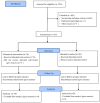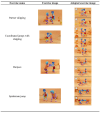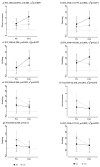Effects of Video-Guided Active Breaks on Motor Competence of Schoolchildren with Special Education Needs
- PMID: 40723013
- PMCID: PMC12294085
- DOI: 10.3390/children12070820
Effects of Video-Guided Active Breaks on Motor Competence of Schoolchildren with Special Education Needs
Abstract
Background: The development of motor competencies in childhood can enhance the trajectory of physical activity throughout life. However, few studies have examined the effects of physical activity programs on motor competencies in schoolchildren with special educational needs.
Aim: Our aim was to analyze the effects of a video-guided active break program on motor competencies in schoolchildren aged 6 to 10 years with special educational needs.
Methods: A prespecified subanalysis of a multicenter randomized controlled trial was conducted with a sample of 161 schoolchildren (7.8 ± 1.1 years, 32% girls) with special educational needs from five public schools in Chile. Participants were assigned to a control group (CG, n = 85) with no active breaks or an experimental group (EG, n = 76) with active breaks. A 12-week video-guided active break program was implemented in the classroom twice daily, five days per week. The intervention was delivered via a web-based platform. Basic motor competencies were assessed using the MOBAK 1-2 and MOBAK 3-4 tests.
Results: A significant time × group interaction was found for object control, F(1154) = 11.365, p < 0.001, η2p = 0.011; jumping, F(1154) = 11.047, p = 0.001, η2p = 0.067; and running, F(1154) = 4.881, p = 0.029, η2p = 0.031. These results indicate that the experimental group showed significantly greater improvements in object control, jumping, and running abilities compared to the control group.
Conclusions: The active break program significantly improved motor skills in schoolchildren with special educational needs. The program proved to be both feasible and effective in enhancing students' motor competencies. School-based guided active break programs may play a role in promoting motor competencies among schoolchildren with special educational needs. Clinical Trial ID NCT06423404.
Keywords: motor skills; physical activity; public schools; special education.
Conflict of interest statement
The authors declare no conflicts of interest.
Figures



Similar articles
-
Interventions in outside-school hours childcare settings for promoting physical activity amongst schoolchildren aged 4 to 12 years.Cochrane Database Syst Rev. 2021 Sep 27;9(9):CD013380. doi: 10.1002/14651858.CD013380.pub2. Cochrane Database Syst Rev. 2021. PMID: 34694005 Free PMC article.
-
Measures implemented in the school setting to contain the COVID-19 pandemic.Cochrane Database Syst Rev. 2022 Jan 17;1(1):CD015029. doi: 10.1002/14651858.CD015029. Cochrane Database Syst Rev. 2022. Update in: Cochrane Database Syst Rev. 2024 May 2;5:CD015029. doi: 10.1002/14651858.CD015029.pub2. PMID: 35037252 Free PMC article. Updated.
-
The Effects of Loving-Kindness Meditation Guided by Short Video Apps on Policemen's Mindfulness, Public Service Motivation, Conflict Resolution Skills, and Communication Skills.Behav Sci (Basel). 2025 Jul 4;15(7):909. doi: 10.3390/bs15070909. Behav Sci (Basel). 2025. PMID: 40723692 Free PMC article.
-
Interventions for patients and caregivers to improve knowledge of sickle cell disease and recognition of its related complications.Cochrane Database Syst Rev. 2016 Oct 6;10(10):CD011175. doi: 10.1002/14651858.CD011175.pub2. Cochrane Database Syst Rev. 2016. PMID: 27711980 Free PMC article.
-
Effectiveness of an online sexual and reproductive health educational program on knowledge, attitudes, and behaviours among senior primary school students: a cluster randomized controlled trial.Reprod Health. 2025 Jul 3;22(1):123. doi: 10.1186/s12978-025-02071-5. Reprod Health. 2025. PMID: 40604802 Free PMC article. Clinical Trial.
References
-
- Carcamo-Oyarzun J., Herrmann C., Gerlach E., Salvo-Garrido S., Estevan I. Motor competence, motivation and enjoyment in physical education to profile children in relation to physical activity behaviors. Phys. Educ. Sport Pedagog. 2023 doi: 10.1080/17408989.2023.2265399. - DOI
Associated data
Grants and funding
LinkOut - more resources
Full Text Sources
Medical

